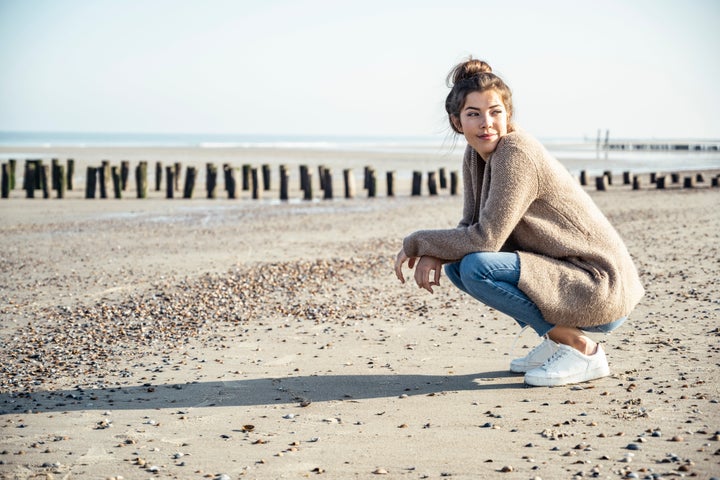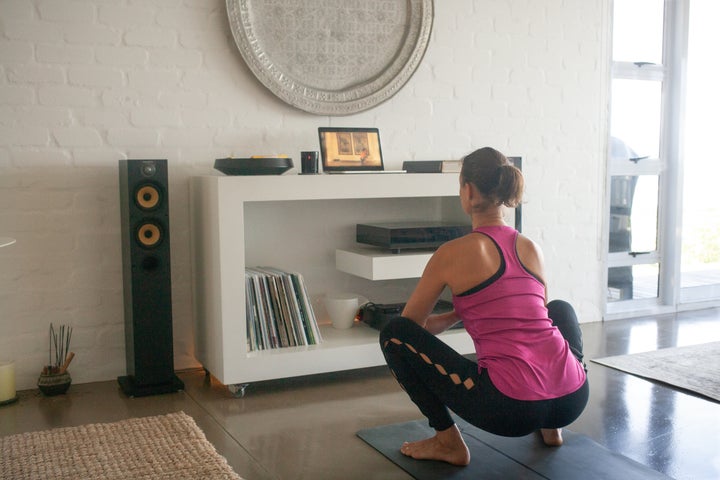
I was recently on a vacation with a friend that involved a great deal of walking around a new city. During a moment of respite, I noticed she dropped into a deep squatting position, rather than plopping down on a nearby bench like I did. When I asked why she wasn’t sitting, she joked, “I’m trying out the Slav squat.”
The pervasive “Squatting Slav” or “Slav Squat” meme refers to images of Slavic-appearing men wearing tracksuits and hanging out together in a deep squatting position with their heels flat on the ground. Searches for this meme often direct people to the notion of the “Asian Squat” as well ― a nod to the ubiquity of deep squats in many Asian cultures.
But in the U.S., squatting is considerably less common (such that in my informal poll of friends, only about half were even able to assume this position without holding onto something).
“We squat as children and in our teens, but as we in the Western world get older we completely stop deep squatting in our daily lives unless we intentionally do it as a form of exercise or in yoga,” said Bahram Jam, a physical therapist at Athlete’s Care Clinic in Toronto. “A true sign of aging is the inability to squat or sit on the floor and be able to get up independently again.”
But should we be hanging out in a deep squat for prolonged periods of time? What’s the optimal approach to the squat? Below, Jam and other experts break it down.
What does squatting do for your body?
“When you squat, your joints are at the end range of motion ― ankle, knee and hip,” noted Bryan Ausinheiler, a physical therapist, personal trainer and nutritionist who’s developed an interest in the deep squat and the cultural differences in how people move their bodies.
Maintaining a deep squat resting position with heels on the ground requires a good amount of balance.
“Think of it like a Slinky, folding over and aligning your weight,” said Justin C. Lin, a physical therapist and executive director of Rehab and Revive Pain and Wellness Center in Tustin, California. “You’re trying to line up your center of balance, so you can kind of crumple down like an aluminum can. It’s this little balance game.”
This balance game, as Lin called it, targets multiple muscle groups, stretching your back, hips, knees and ankles.
“The ankles, knees, hips and back move into their full rage of flexion, loading the joint and the cartilage which is necessary for maintaining good cartilage health,” Jam said.
For some people, getting into a deep squat position with their heels on the ground is difficult or may even feel impossible. This is often the result of compromised ankle dorsiflexion ― basically the ability to bend your ankle and move your foot toward your shin.
“Full ankle dorsiflexion is needed to keep the heels down during a squat,” Jam explained. “If people have stiff ankles either due to genetics or due to an old ankle injury, keeping the heels down will not be possible. The modification is to simply hold on to a doorway or a bar and go into a deep squat.”
Ausinheiler noted that 45 degrees is the optimal ankle range of motion for achieving a deep squat and that people with less than 35 degrees will likely struggle to get into the position.
“When my babies were born, I measured their range of motion at about 75 degrees,” he explained. “That’s why it’s so easy for toddlers to squat. They have the body proportions of a chimp, so their shins might even be totally vertical.”
As children grow, their body proportions change, and their limbs get longer. Squatting thus becomes more difficult.
“Short people have proportionally shorter limbs in general, so squatting will be easier for them,” Ausinheiler explained. “The people who break world records in squatting are usually short.”
Many kids don’t use their full range of ankle motion, so it decreases over time. Ausinheiler believes children should be encouraged to squat more to help maintain a 45-degree range of motion.
“The range you use as a child will determine your capacity to squat, even more so than your height,” he explained. “I think kids shouldn’t be using chairs and desks at school until second grade. We should have them on the floor more to maintain that range of motion.”

Is squatting good for you?
“All movements that are within the capability of the human body are good for us, so squatting is technically of course good for the body,” Jam said. “But holding any posture or position for a prolonged period of time is not good, as it will irritate certain parts of the body.”
If you turn your neck to the right or left all the way to the available range of rotation, that’s great for keeping your neck healthy and functioning, he explained. But turning your neck all the way and then holding it there for 30 minutes will inevitably cause discomfort as you try to move it back to the center.
“The same goes for maintaining healthy ankles, knees, hips and back,” Jam noted. “By squatting we move them through their full available ranges.”
Remaining in a squat position for a prolonged period of time is also not particularly practical.
“Stretching is certainly better than sitting,” said Matthew Stults-Kolehmainen, an adjunct associate professor who specializes in exercise physiology at Columbia University. “However, much of the time we are sitting for a purpose (e.g., work) and thus sitting like this would be unadvisable. Most people cannot work in a squatted position.”
There are potential downsides to prolonged squatting as well. Ausinheiler noted that hockey goalies squat for extended periods and tend to develop hip issues ― though their knee positioning likely contributes to that as well.
“In a deep squat, you’re creating impingement in the hip,” he said. “The hip joint is pinching the front of the labrum.”
But, as with most things in life, different people respond differently.
“It all just depends on the body,” Ausinheiler said, noting that some people might be more prone to adverse health effects from prolonged squatting. “Deep squatting can also cut off blood supply to your leg, so your femoral artery is kinked. Sometimes your feet and legs will eventually go numb.”
He also pointed to a study out of China and the U.S. that found elderly people who had spent more than an hour squatting each day in their 20s were more likely to have knee osteoarthritis. However, spending less than an hour in the squat position was not associated with increased rates of arthritis. And a later study suggested that occasional squatting actually decreased the risk.

So, should we be squatting more?
“I don’t necessarily think we should spend more time hanging in a deep squat, certainly not more than sitting in a chair or standing, but it’s a good movement to be able to do, a good capacity to have,” Ausinheiler said. “Full bandwidth of movement is something we should work on so that we can do things like put items in an overhead compartment or reach things on our toes.”
He noted that there might be times in your life when you’ll need to use a squatting toilet, pick something up from the ground or squat down with a small child.
“Just like anything, there’s balance,” Lin said. “If you want to be in a stationary squatting position for 15-20 minutes a day as part of your routine, I think that’s great ― it helps with your balance, joint mobility, muscles and pelvic floor. My friends and I might hang out and squat like that as we drink our boba, but then we get up and move around. We aren’t necessarily doing it all day as we work on a laptop for instance.”
Maintaining a good range of motion and mobility is all about implementing a variety of postures and movements into your everyday life.
“Squatting is a self test of how healthy your lower extremities and your back is,” Jam said. “To maintain that health, I think we all should squat every day at least once, even if it is for a few seconds. After all, the rule is use it or lose it.”
If you’re concerned you’ve lost your ability to deep squat, it’s possible to get at least a little bit of it back.
“There are exercises, mobility type movements that increase joint range,” Lin said. “You can build ankle, hip, knee and pelvis ability and awareness.”
Ausinheiler said he believes it’s possible to get back up to 5 degrees of ankle range of motion, though the process might be challenging.
“If someone has pain and is unable to do a deep squat, they should consult a physical therapist who can figure out the reasons for the limitation and help them achieve that goal,” Jam said. “My patients gain so much self-confidence when they are finally able to squat, even if it is by holding on to something and get up again.”
Although deep squatting can be a great tool in your bodily arsenal, that doesn’t mean it’s essential for everyone, so don’t despair if it’s just not happening for you.
“Some people should not squat,” Stults-Kolehmainen said. “Always consult with a credentialed professional before doing unaccustomed exercise that might be putting inordinate stress on the body. For a majority of my patients, doing a sit to stand from a chair, 20-30 times, simulates a squat. This would develop fitness much better.”
He cautioned against the “false choice” between sitting or doing a deep squat.
“If you want to minimize sitting, just stand up,” Stults-Kolehmainen said. “Get some ‘exercise snacks.’ You don’t need to do a fancy squat to break up sitting time. Simply stop sitting.”